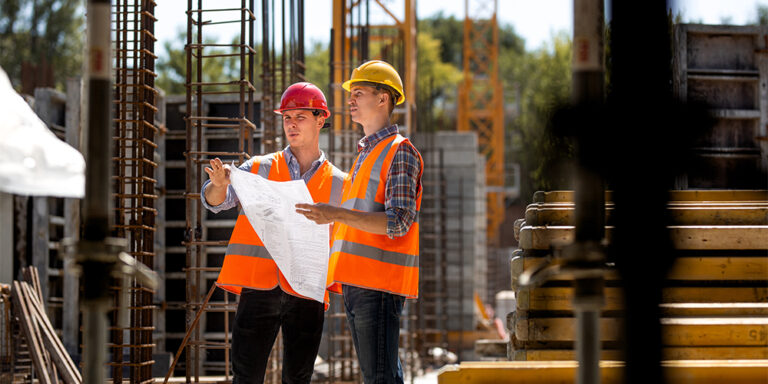— 9 min read
A Construction Expert’s Guide to the Bill of Quantities
Last Updated Mar 26, 2025
Last Updated Mar 26, 2025

A Bill of Quantities (BoQ) is a precise list of all the necessary materials and labour for a building project. It’s like a shopping list for a construction project, with the type, amount and price of each material that a company needs to purchase to be able to build something. It also details the specific labour types and costs for carrying out the building work. Some people also call it a Bill of Materials, but BoQ is more common.
Table of contents
Key Components of the BoQ
There are four key components of a standard BoQ. These are:
- Item descriptions: Clear, specific descriptions of each component or task needed
- Quantities: Exact amounts or measurements of each item, e.g. m2, m3, etc
- Unit rates: The cost per unit of each item, based on historical data or current market prices
- Total costs: The overall cost of each item or labour type, calculated by multiplying the quantity by the rate of a single unit.
Why is the BoQ important?
A BoQ is an essential document in the pre-construction phase because it accounts for every single item that a project team needs to complete a build. BoQs are usually prepared as part of the tender documentation that construction companies and subcontractors issue to suppliers so they can obtain and agree on a price for materials. Here are four reasons that BoQs are important:
Standardisation in Tendering
A Bill of Quantities allows a company to ensure standardisation, or uniformity, in the tendering process. This helps them to compare bids with accuracy and confidence. It also helps everyone involved in a construction project to stay on the same page, improving levels of understanding, collaboration and transparency.
Ensures Fair Pricing
A detailed BoQ helps to reduce the guesswork that can hold a project back. In particular, it
helps with fairness and accuracy in price estimates. By providing details such as the market price, it helps enable honest and evidence-based negotiations so that a client and construction company can agree on prices.
Aids Tender Analysis
A BoQ simplifies tender analysis, which is the process of evaluating and comparing bids. When a client receives a Bill of Quantities with a bid for a project, they can compare the costs of different bids with ease. This helps them to choose the best value for their project without sacrificing quality.
Compliance
By providing a list of the exact materials, items and specifications, the Bill of Quantities can help contractors to stick to project requirements. It helps keep everything consistent and makes it easier to check if contractors are using compliant methods and materials.
Shape the Future of the Built Environment at Procore's Construction Summit
Engage with construction leaders and discover the latest technology and best practices that are driving change across the industry.

The Benefits of Using a BoQ During Construction
Creating and using a Bill of Quantities helps to speed up processes and reduce guesswork before and during construction. Here are some of the areas that benefit from a BoQ:
Contract Sum Agreement
A BoQ makes it clear what the final contract sum is, and how the bidder arrived at that figure. Defining these costs and showing how each line item adds up to the final sum helps to show the sum of the different parts to a client. This reduces the need to explain or justify the final contract sum, as it is explained in the BoQ. This means there are no surprises down the line, too, which helps with client satisfaction and keeping a good reputation.
Schedule of Rates
A schedule of rates is a list of the pre-determined prices for materials and labour costs of a construction project. The schedule of rates informs the cost price on the Bill of Quantities. When companies use both documents together, they can get accurate estimates thanks to standardised pricing.
Interim Valuations
BoQs also help with interim valuations, which are essentially a progress check on the work. Interim valuations calculate how much a client owes a construction company based on the work that has been completed. The Quantity Surveyor can calculate how much a part of a project is worth using the costs and materials listed in the BoQ, based on the quantity of materials, the hours of labour, and the price of each of these.
Final Account preparation
When it’s time to settle accounts and work out final payments, the Bill of Quantities simplifies the preparation of the final account, helping all parties to agree on what they have delivered, and the associated costs. Having the detailed list of all the materials used and the respective prices means there’s little room for debate: the costs are already outlined.
What standards and methodologies inform the Bill of Quantities?
In the UK, there are standards that offer a commonly used method to create a Bill of Quantities. They provide consistency and help companies use best practices. These include the Standard Method of Measurement 7th Edition (SMM7) and the New Rules of Measurement (NRM).
What is the SMM7?
Until 2013, the most commonly used standard for preparing a BoQ was the SMM7. The RICS published the SMM7 in 1988, and the first edition dates all the way back to 1922. It provided detailed information including classification tables and instructions for how to measure building works. This ensured that everything was measured in a consistent manner so costs could be calculated accurately based on units in the BoQ.
What are the New Rules of Measurement?
The New Rules of Measurement were also published by the RICS, almost 100 years after the first edition of the SMM. The RICS published the NRM 1 in 2009, and the latest update, the NRM 3, in 2014. They replace the SMM7, as many industry professionals began to see the SMM7 as outdated for the modern industry.
There are many similarities between the SMM7 and the NRM. However, the NRM allows extra flexibility and the inclusion of smaller items that were not covered by the SMM7. There are also clearer definitions and guidelines for costs, provisional works and allowances for risk. The NRM is also more compatible with Building Information Modelling.
Preparing a BoQ
Preparing a Bill of Quantities needs close attention to detail and collaboration between different people involved in the pre-construction phase:
Design Stage
The design stage is where the BoQ’s journey begins. At this early phase in the construction process, architects and engineers work together to translate a design into plans and drawings. This sets the stage for the next phase, which is called ‘taking off’.
Taking Off Process
The taking off process is where the plans written down in the form of drawings become actionable data. It’s where you extract the exact quantities and measurements from the drawings so you can evaluate how much of each material is needed. With these numbers extracted, it’s then ready to be formatted into an approximate BoQ.
Approximate BoQ
An approximate BoQ is exactly what it sounds like: an early estimation which provides a rough but close estimate of how much a project will cost. It helps to set expectations and give everyone an idea of the quantities and costs of materials, and even the projected profits of a build. This is then developed by subcontractors, who take this approximate BoQ and develop it line by line for their needs.
The evolution of the BoQ
BoQs have come a long way over the last century. Traditionally, BoQs were painstakingly written and worked out by hand (with lots of crossing or rubbing out). Experts created them, as a BoQ needed a high level of precision and experience so that they were accurate and efficient.
As modern technology evolved, construction companies started to use digital technology to speed up the process of creating BoQs. Solutions like Microsoft Excel became more commonplace, and made it easier to create and share BoQs. But Excel is no longer the innovative new solution it once was. Today, integrated construction platforms include the functionality to create BoQs with templates, making the process more painless and efficient.
Who is in charge of preparing the BoQ?
It varies from company to company, but generally, whoever prepares responses to bids is in charge of preparing the BoQ. For smaller companies, this may only be one person. Larger companies will often have a whole team or department responsible for BoQs.
Challenges in preparing BoQs
Even with all the advancements, sometimes there are still challenges with creating BoQs. Here are some of the common BoQ issues regularly facing construction professionals:
- Inaccurate or inconsistent data/measurements
- Human error
- Outdated information
- Difficulty accessing the right documents
- Inclusion of unnecessary items
How do BoQs enhance coordination?
BoQs help to enhance coordination by enabling better collaboration between individuals and teams in a construction project. The BoQ gives everybody a complete overview of what is needed in order to successfully complete work. This helps to create a shared understanding of requirements, is a good reference point when communicating about a project phase, and helps to keep people accountable for their part in a project.
Free Download
Bill of Quantities Template
Many construction professionals in charge of creating a Bill of Quantities use templates such as this to make the process more efficient and simple. They use common data processing computer programmes for organising and calculation, removing some of the problems associated with human error.
- Free starter template
- Ready-to-use
- Trusted by construction professionals


Future trends
Emerging technologies are changing construction all the time. We’ve seen the rise of practices such as BIM become more common, and in turn create a more efficient work life for construction professionals. In terms of BoQs, it’s likely that artificial intelligence will soon find new efficiencies and speed up the process further. Automation is already helping to break down line items in the BoQ. Generative AI could take it to the next level, filling out information based on company or industry data.
How construction management software can help
Construction management software can make the BoQ process much easier and quicker. It can automate the measurement and tracking of quantities from drawings, which reduces the risk of human error such as typos or misreading quantities. It can also perform cost estimates at the click of a button, as well as other kinds of calculations you might need.
Software provides a single source of truth which is up to date, by making sure that everyone is accessing and editing the same documents, and that users can amend them in real time. To stop things from getting out of control, software administrators can grant different levels of access and editing rights so that some people can only view the document while others are able to make changes.
Categories:
Tags:
Written by
Jakir Hyder
Experienced construction engineer supporting the industry in digital transformation using experience and knowledge gained from Tier 1 contractor through customer focused and outcome based solution design during the presales process.
View profileReviewed by
Nicholas Dunbar
29 articles
Nick Dunbar oversees the creation and management of UK and Ireland educational content at Procore. Previously, he worked as a sustainability writer at the Building Research Establishment and served as a sustainability consultant within the built environment sector. Nick holds degrees in industrial sustainability and environmental sciences and lives in Camden, London.
View profileExplore more helpful resources

Construction Document Software: Essential Tools for Project Success
Construction projects depend on extensive paperwork, including designs, contracts, RFIs, and compliance records. A single misplaced document can trigger delays, disputes, or compliance violations. Despite increasing digital adoption, many teams...

Construction Planning: A Guide to Successful Project Execution
Every successful construction project begins long before the first brick is laid. Indeed, behind each structure – whether a towering skyscraper or complex infrastructure project – lies a carefully crafted...

Leveraging Analytics for Better Financial Forecasting in Construction
Financial forecasting is a difficult task in any industry. In construction, where companies need to manage volatile material costs, labour shortages and variation orders on a daily basis, fluctuations in...

Strategies to Prevent Rework: The Importance of Clear Instructions
In construction, “rework” is the dreaded process of redoing tasks due to mistakes, quality issues, or safety concerns. This unnecessary work drains budgets through wasted materials and labour while causing...